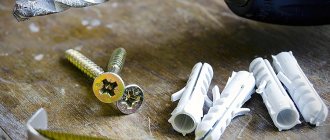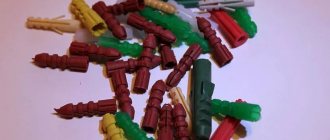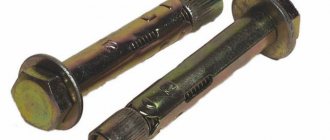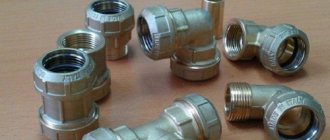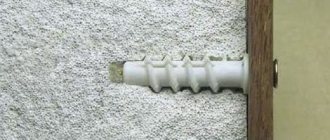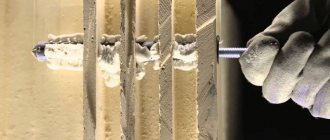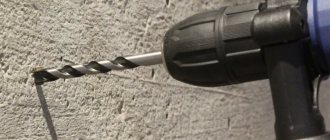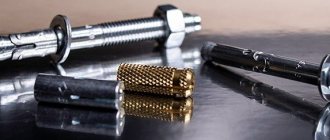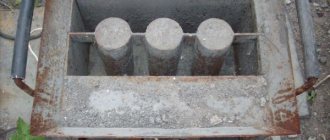The dowel is one of the most commonly used fasteners. Typically, it is necessary to secure fasteners into solid solid surfaces. A screw, screw or nail is installed in a universal dowel, which pushes it apart, which leads to friction. This is the principle of operation of this fastener. If you need to attach something to a concrete wall, it is almost impossible to do this without dowels. Therefore, they are often used in repair work.
Installation of dowel nails using a special gun
All the previously described options for driving dowel fasteners imply that the nail is driven into the dowel. But there is another way to install the mount in question, which involves using a construction gun. This modern installation device allows you to “shoot” the structure being fixed to the base using a dowel-nail.
In this case, a special dowel fastener is used, which by and large does not involve the use of the dowel itself. The presence of a special washer on the nail ensures a tight fit of the fastener into the solid material.
The essence of the technology for operating the gun is that after shooting the dowel-nail, the washer on its tip moves to the head of the fastener and is tightly fixed there.
This dowel-nail is used when fastening metal structures to solid bases made of natural stone, concrete, steel with low carbon content, and brick. The gun and the described type of fastener are very often used when installing canopies on the balconies of buildings.
They produce “nails with washer” with a length of 30 to 80 millimeters, a cross-section of 4.5 and 3.7 millimeters from steel coated with zinc. It is extremely rare to find nails with a cross-section of more than 4.5 millimeters on sale.
I think you already understand how to use a dowel-nail. Humans do not encounter any particular difficulties with this fastener.
In this case, it is very important to choose the right type of fastener, since dowel-nails, which, for example, perfectly connect the surface and the concrete base, are absolutely not suitable for fastening chipboard or plasterboard
It is enough to contact the consultants (sellers) of a hardware store that sells various types of fasteners (for example, slate nails or finishing nails) to obtain comprehensive information about the types of dowel devices.
They will also advise you on how to use dowel nails. However, after carefully reading the article we have prepared, you will probably no longer need this information. You can easily mount fasteners into any type of surface without outside help!
Dowel Molly
It resembles an umbrella in its principle of operation. Withstands significant loads - up to 35 kg.
The installation process is as follows:
- A hole is drilled in the wall or ceiling to match the diameter of the dowel (usually 8 mm).
- The sleeve is inserted into the hole so that the teeth located on the cap cut into the surface. This will prevent the fasteners from turning.
- Screw in the screw until the opening triangles dig into the drywall on the back side of the sheet, ensuring a secure fixation.
The advantages of Molly dowels are obvious: due to the formation of a cone-shaped structure on the back of the gypsum board, they increase the support area and prevent the sheet from breaking under load. Disadvantages include high cost and the need for free space behind the plasterboard.
Note! Molly cannot be dismantled: you will have to break the wall to remove it.
And here is a video instruction for installing Molly:
USEFUL INFORMATION: What is the difference between an RCD and a difavtomat?
Distinctive features of dowels for brick and concrete
A clear definition for fasteners is the fundamental principle that you will choose the right fastener and, accordingly, get the expected result after its installation. In practice, dowels for hard materials are not very advisable to use on brickwork. Moreover, if such a wall consists of bricks with voids inside. A fastener for concrete foundations is not at all what you need in this situation.
For such a base, there is a special dowel for bricks with voids inside; it has a special structure and, accordingly, installation specifics. First of all, it is an elongated plastic or metal bushing, the structure of which has a double thrust system mechanism. This design guarantees reliable fastening only for the reason that one of the spacers in any case ends up on a solid base, where it is fixed.
A threaded rod of the appropriate diameter, a self-tapping screw and other anchor fastening elements can be used as a rod, which plays the role of a spacer element. It all depends on what exactly you need to mount on the wall, and how much force a particular device will exert on the mount. Naturally, an important point before installation is the choice of the length of the fastening element. But you should not choose fasteners that are too long; in the future, difficulties may arise when installing the fastening device.
But the dowel-nail for concrete is technologically designed to work on a completely different principle. For example, in a hollow material it will never create a strong fastening connection, no matter how long we use it. The process of installing such fasteners itself involves driving it into the hole, which significantly speeds up installation work. In loose materials, using this technology, we will simply destroy the mounting hole and will not achieve high-quality fastening.
Kinds
There are several types of dowels that allow you to attach suspended structures to gypsum boards:
- Butterfly.
- Driva plastic or metal screwdriver.
- Molly.
- Fischer dowel.
- KNAUF Hartmut.
- An ordinary dowel-nail.
- Spring-loaded.
Each of these types of fasteners has advantages and disadvantages. To figure out which one is more profitable to use in a specific situation, let’s take a closer look at them.
What is a dowel-nail
A dowel-nail is a special product used to perform fastening work. It consists of two elements - a special nail and the dowel itself, and is used for mounting objects to concrete, brick, stone, and other solid, dense materials. There are also types of the described fasteners designed to work with chipboards and drywall.
The design of the dowel-nail is very simple. It is made in the form of a cylindrical rod, which consists of a spacer part (it expands during installation and allows for reliable fastening) and a nail that is familiar to everyone.
In some cases, the fastener we are interested in may be additionally equipped with a special cuff that acts as a limiter that does not allow the fastener to fall into the hole made. The shape of this cuff can be different, for example, cylindrical or hidden.
Also, modern industry produces dowel fasteners with a thread applied to the nail and a slot, which is located on the head of the product. This element can be mounted using a screwdriver. Working with it is quite simple, since the process of inserting a nail into a dowel is made easier due to the presence of a “smoothed” thread in the product. Let us add that the top of the thread of this mounting device is directed towards the head. Purely externally, the dowel-thread is no different from the standard thrust thread.
Most often, dowels are made from polyethylene, polypropylene or polyamide. But the dowel-nail itself is made from steel alloys with a zinc coating. To be fair, we note that there are many fasteners of the described type on the market without additional coating. Standard dowel diameters are 5, 6, 8 and 10 millimeters, and their length ranges from 30 to 160 millimeters.
Material for making dowels
Most dowels are made from polymer materials - polyethylene, polypropylene and polyamide. Such elements are characterized by high performance, availability, ease of installation (there is no need to make significant efforts to attach them) and low cost.
Common materials for making dowels are polyethylene, polypropylene and polyamide
Products made from polypropylene are hard, wear-resistant, and resistant to high temperatures. Such elements are intended exclusively for indoor installation, which is due to their sensitivity to sub-zero temperatures. During long-term operation with temperature fluctuations, deformation of the dowels and the appearance of cracks may occur.
Polyethylene dowels are characterized by low weight, ductility, ability to operate at low temperatures and low cost.
The most reliable and durable products are dowels made of polyamide or nylon. They are characterized by high wear resistance, resistance to mechanical stress and temperature changes.
Dowels can also be made of metal. For this purpose, stainless steel, galvanization, alloys based on bronze or brass are used. Iron dowels are distinguished by high strength qualities, rigidity, the ability to withstand large mechanical loads and durability without compromising the integrity of the structure.
Important! The surface of the metal dowels has a special galvanized coating that prevents the formation of corrosion.
Metal dowel
Dowel-nail how to use it when working with brick and concrete
If you are installing a fastener in a brick structure, you should follow these steps:
- We choose the optimal place for the dowel (usually this is understood as the center of the brick).
- Using an impact drill, we begin to drill into the material. This process must be performed very carefully (especially when starting drilling) so that the masonry does not crack under the influence of the tool. You can increase the speed of the drill after about 10 millimeters of brick have been drilled.
- From the resulting hole, we blow out brick crumbs and the resulting dust with a vacuum cleaner, after which we boldly hammer in the fastener using a hammer.
When working with concrete surfaces, the fasteners are mounted as follows:
A hole is marked with a punch and a hammer. A hole of the required depth is punched (with a hammer drill). Please note - the marking of the dowel-nail, which indicates its cross-section, must coincide with the marking of the drill
It is also important that the length of the dowel is 5–6 mm shorter than the hole being punched. Using a vacuum cleaner, concrete dust is removed, and then the dowel cartridge is deepened with a hammer. After all these steps, the nail is driven in. It is advisable to leave 2-3 millimeters of free space from its head, which will be required for hanging.
How to choose dowels
It is recommended to select dowels depending on the place where they will be used. It is equally important to consider the future load:
- So, in order to secure heavily loaded structures, for example, such as mounted exercise machines and wall bars, it is best to take dowels with a mounting depth of at least 85 mm.
- For horizontal fixation into a concrete or brick wall, it is recommended to choose fasteners whose fastening depth is at least 30 mm, and the outer diameter of the dowel is from 7 to 11 mm.
- If fasteners are needed for a suspended ceiling, ceiling lamps and other products where the main load will be located from below, then you should choose fasteners with transverse notches and spacer antennae.
- If dowels are selected for a ready-made hole, then it is important that its diameter and the parameters of the fastener match. In this case, it must be no less than the size of the hole.
- If mounting fasteners are used in the work, then in order to prevent the destruction of weak walls (this can happen at the point of support), the dowel acts as a softening pad. In this case, on hard surfaces, the fastener will fit quite tightly to the fastener, so that the load is distributed evenly.
How to drive a dowel nail into drywall, ceramic or tiles
When installing drywall, you should take into account in advance the weight of the load that is attached to it. In cases where the weight of the load is quite high, it is impossible to use a dowel fastener, since it will simply destroy a fairly light plasterboard surface. In other situations (light load weight), driving a dowel-nail is a very simple procedure:
- a hole of the required cross-section is made in the drywall;
- the fastener is inserted all the way into the hole (in this case, you should not hit the fastening element with a hammer with all your strength, but only lightly tap);
- The screw is tightened manually or using a screwdriver.
When working with tiles made of tiles or ceramics, installation of fasteners is also simple, but the work should be done with extreme caution, given its high fragility. The fastening diagram is as follows:
- a marker marks the point of entry of the fastener into the tile (this can be either a seam or the surface of the material);
- Lightly tapping a metal screw using a self-tapping screw makes a hole on the surface of the enamel (up to 0.5 millimeters), and only after that use an impact drill, which drills through the tile (ceramics) to its entire thickness.
Do not forget that you will also need to make a hole under the tile in accordance with the instructions for brick or concrete (they are outlined above), and then install the fastening device into the tile and brick or concrete surface.
How to install a dowel in a wall: step-by-step instructions
Before installing the dowel into a concrete wall, you should prepare the necessary materials and tools. Fasteners are selected depending on the type of base. To do this you will need dowels with screws or self-tapping screws, a hammer, an electric drill, and a Pobedit drill bit.
Related article:
Which screwdriver to choose so that it becomes a real helper around the house
Main types of devices according to purpose and methods of use. What characteristics are considered decisive when purchasing a product? Manufacturers.
The first step is to mark a place for the hole, which is drilled using a drill. It should be held strictly perpendicular to the base. Using a manual method, the hole cavity is cleaned from cement chips and dust. To do this, you can use a vacuum cleaner. The diameter of the hole must match the cross-section of the dowel, which must fit into it with some effort. If the hole is too large, the fastener will fall out of it.
Important! The length of the dowel must correspond to the size of the self-tapping screw that is used in tandem with it.
The dowel is inserted into the hole and, using a hammer, driven into it until it stops so that the edge of the part coincides with the surface of the wall. The process is performed carefully, without powerful impacts that could damage the fastener. A screw is screwed into the dowel cavity. If a nail is used, it is driven into the cavity of the fastener.
Step-by-step algorithm for installing a dowel: 1 - drilling a hole, 2 - installing a dowel inside the hole, 3 - driving in a self-tapping screw, 4 - finishing the surface
When deciding how to properly install a dowel for aerated concrete, you should take into account the following recommendation. Self-tapping screws for fastening elements must be selected with a larger diameter. This will contribute to a significant expansion of the dowel walls, providing a rigid and reliable fastening. When drilling aerated concrete or foam concrete using a hammer drill, the breaker mode is not used, since the hole may turn out to be too large and have an inaccurate configuration, which will complicate the fastening of the dowel.
Why do you need a dowel?
A dowel is a specialized fastener designed for installation and connection of various structures. There are a huge variety of different types of dowels, each of which is suitable for a particular material: concrete, stone, drywall, wood and others.
This fastening is most often used when there is no access to the edge of the connecting rod of a conventional screw. That is, when it is necessary to make a non-through hole, for example, to install a cabinet in the kitchen or a shelf in the living room. Also, dowels are ideal for hollow walls. Other fasteners in this situation will simply be ineffective.
The principle of operation of the dowel is very simple. A dowel is a kind of buffer between the self-tapping screw and the wall, fixing the entire structure due to the presence of special ribs and “hooks”. That is, it works like a spacer.
A dowel is a cylindrical rod made of polypropylene, nylon, polyethylene or even metal. Structurally, the dowel has two parts: an expansion one - it expands during installation, securely fastening into the working material, and also a non-expansion one. Some types of dowels are equipped with a limiter cuff that prevents them from falling into the drilled hole.
Features of using dowels
When choosing a dowel, it is not enough to focus on its shape; it is also important to know what size (length, diameter) to choose. For each working surface you need to select your own fasteners
The “six” dowel (6*40) is suitable for installing profile structures in cinder block houses. By choosing a different size, it will not be possible to make repairs, since all the fasteners will simply fall out of the drilled holes.
For panel houses (as well as those where there are no voids in the walls), the best option for dowels is 6*60 or 6*80. With them, everything will be securely fastened, nothing will fall through or fall out even on the ceiling.
When choosing the length of the dowel, it is worth remembering the load that the fastener will be subjected to in the future during operation. The shorter the dowel and self-tapping screw, the less load it will withstand. The diameter is also important. For ordinary housework (hanging a cabinet, mirror or wall unit), dowels with a diameter of 8-10 mm are sufficient.
The only difference is the depth of the hole being drilled, since the load on the dowel is different. For a cabinet, 3-5 cm is enough, and for a wall unit or a heavier cabinet or shelf - 8-10 cm. Another important question that arises before the master is what kind of drill is needed for the dowel.
To answer this, you first need to know what surface will be drilled and what load on the structure is planned in the future after the work is completed.
How to choose a drill for a dowel?
The most important rule is that the drill number must match the number (size) of the dowel. T
That is, ideally, the dowel should be difficult to hammer into the wall, otherwise, a situation is possible when the dowel simply falls out or fails. As for the quality of drills, experienced craftsmen advise using pobedit ones, since buying more expensive ones does not make much sense.
It’s easy to make a hole for a dowel (for example, let’s take dowel 10): First, take a smaller drill, for example a 8-piece. Make the hole slightly smaller in depth than necessary using the impact mode.
Types of dowels for concrete
There is a fairly large number of fasteners for concrete, the most famous and effective of them are presented in the table:
| Dowel type and photo | Peculiarities |
| Spacer | This type of dowel for a concrete wall differs from other types in the size and shape of the screws. They are usually made in a slate shape, allowing the pieces to be driven into the concrete wall with a hammer. Sleeves or fasteners of cylindrical or tubular shape can be varied: with two or three spacers. They often have spikes, which increases the reliability of fixation. |
| Butterfly | These types of concrete dowels are used when working with thin wall coverings. The sleeve is inserted into the hole, and its back side is folded due to the insertion of the screw into the concrete wall. This is how the dowel is fixed to the wall. |
| This fastener is similar to the spacer type; the fixation is made using the “butterfly” type. Its peculiarity is the ability to use it for a wide variety of wall surfaces. |
| Fasteners are used for mounting structures to concrete made of different materials. The nail is driven into the wall with a hammer, but it is better if you use a special gun. |
| The façade tool is used for constructing frame structures on a brick and concrete base. Dowels share some of the same characteristics as the expansion type, but are slightly longer and have a larger head. The rod and sleeve are made of impact-resistant materials. |
| This is not an ordinary fastener. It contains a special capsule that contains chemicals, so the screw is made of metal. A dowel is used for lightweight concrete. When screwing in the element, the chemicals act as glue, so you need to wait until the base hardens. This usually lasts from two hours to a day. |
| Works only for aerated concrete surfaces. A special feature of this type is the wide thread, which guarantees strength when using similar dowels for porous surfaces. |
| This fastening is used for wall blocks made of polystyrene concrete. Its sleeve resembles a spacer sleeve, but has a spiral appearance. The GB type dowel can withstand quite heavy loads. They can be effectively used for attaching hanging cabinets, hoods, shelves and other heavy household items. |
Self-tapping screw in concrete without dowel
Dowel for expanded clay concrete blocks
Dowel for concrete l=60 with a diameter of 10 mm
Dowel fastener. Types of products
These products are divided into categories according to:
fastening method
The design features, as well as the base material, are taken into account. If the base is of high density, which causes certain difficulties in the process of fastening various elements, you should use dowels for brick or concrete
To work with such surfaces, you can choose: Expansion dowel. Depending on the manufacturer, the product may differ in shape, as well as in the number of teeth, ailerons, and spikes. Universal fastener. In solid materials it manifests itself in the same way as the spacer type, but in hollow materials it shows different qualities. Facade dowel and frame. The products are designed for fastening into dense bases, even if they are classified as slotted. Nail type. Designed for mass quick installation. Most often requires the use of a mounting gun. If the work will be carried out with loose or hollow materials, then in these cases it is better to choose a universal option, frame (can be used when installed in a foam concrete base during the installation of plastic door and window structures), driven (for aerated concrete), as well as screw-on, panel and sheet dowel.
type of installation
In this case, it is not the method of immersing nails into dowels that is taken into account, but the installation of the dowel itself. Today there are two methods: Pre-installation
The fasteners are fixed into the base. The attached element fits as tightly as possible to the “body”. The largest percentage of types of dowels work exactly according to the mentioned principle (universal, nail, spacer). Through installation. Before fastening into the base, the fastener must pass through a void area or a certain layer of intermediate material. To carry out this process, a product with an elongated non-expanding part is used. We are talking about frame, facade, and roofing dowels. In addition, there are models of fasteners for insulation. They can be either spacer or non-spacer. They are distinguished by the presence of a rather large cap (diameter - from 45 to 90 mm), which allows them to hold loose material, as well as soft ones.
- material. Most often, dowel fasteners are made using plastic. This is explained by the fact that the level of installation strength is determined by the ease, as well as the force of deformation. Plastic is endowed with elasticity and viscosity, which allows it to deform more easily than other materials. At the same time, the plastic does not lose its characteristics. Thus, today there are dowels made from the following materials:
- Polyethylene. The products are lightweight and resistant to acids. The raw material is endowed with excellent viscosity and is able to retain its qualities during deformation. Fastening material made of polyethylene is resistant to corrosion reactions and is not subject to cracking after long-term use. It is resistant to low temperatures (used at –40 degrees Celsius).
- Polypropylene. It has high hardness and wear resistance, but cannot be used at very low temperatures. But it performs well at high temperatures (deformation is observed at +140 °C or more).
- Nylon or polyamide. Products made from this material are endowed with a high level of rigidity and strength. They are resistant to mechanical stress and vibration processes, and are durable. A nylon dowel is recognized as a more reliable fastener, but it is not recommended to use it in frosty or humid weather.
Types of fasteners
Today there are various types of these fasteners, each of which differs not only in material, but also in the principle of fixation. Not long ago, such fasteners were cut from pieces of wood and inserted into the hole. Today, hardly anyone uses these products. After all, nowadays you can find dowels on sale for almost all occasions. The materials of modern fasteners are plastic and metal. Drive-in nylon dowels are most commonly used. Together with self-tapping screws, they are indispensable for working with any materials.
Let's look at some types of dowels available for sale today:
- Dowel for concrete. To manufacture such a fastening element, polypropylene or nylon is used. These dowels are still well fixed to stone and brick. In addition to the fasteners themselves, self-tapping screws are required. For ease of work, you can use a dowel gun.
- The material for the manufacture of dowels intended for sheets of plasterboard or gypsum fiber is usually metal (in rare cases, plastic). These same fasteners hold well in cellular concrete. The use of these dowels requires the presence of self-tapping screws and construction screws. Metal dowels for drywall are equipped with a tip in the form of a sharpened drill. Thanks to this, they can be installed even without holes in the work surface.
- To fasten materials into concrete, expansion dowels made of polypropylene are often used. Such fasteners have special spacers in their design, which improve fixation during installation.
- Mounting dowel made of polypropylene. It is better not to use it for exterior decoration because... the material used may crack at low temperatures. As for nylon fasteners, they can be used in almost any conditions.
- Dowel nail. For its manufacture, nylon or polypropylene is similarly used. As for the nail itself, it is usually steel. For retention, it has knurling in the form of reverse cones. Such fasteners are used when it is necessary to secure baseboards, metal profiles, window openings, slats, lathing, boards. The dowel-nail usually fits well into a wall made of stone, brick and concrete. As a rule, these products are used when quick and extensive installation of small structures is required. Next you can see the dowel nail in the photo:
- Frame dowel. Made from metal. It is actively used as fasteners for window and door openings. In addition, it is used if it is necessary to secure elements of the thermal insulation layer and sheathing through a layer of plaster. They can be called dowels for thermal insulation. There are two types of these fasteners. The former are used to work with hard materials, and the latter - with soft materials.
- Wall dowel (otherwise known as façade dowel). The main materials for them are nylon or polypropylene. These fasteners can be used to attach anything to almost any wall. You just have to additionally purchase screws with a diameter of 4 to 18 mm. In addition, you need to make a hole in the wall in advance for a dowel of a suitable diameter. The fastener is held in the hole due to the presence of directed antennae.
- There is also an adjusting metal dowel, which is used to secure the sheathing slats at a certain distance from the surface. This distance is required in order to make the sheathing after some time. Thanks to separable dowels and screws, you can change the position of the slats at your discretion.
- Metal “butterflies” are ideal for mounting in various hollow structures. It is important that these fasteners can withstand quite heavy loads.
- To fasten window and door openings, a universal nylon dowel is often used. It is also suitable for fixing metal sheathing and slats. In addition, this dowel is used to secure interior finishing elements such as suspended ceilings.
- To fix the mineral wool insulation, a plastic dowel or special fasteners made of a plastic base are also used. The material is fixed using a metal nail. For this fastener, a hole must be made in the wall. Fastening is carried out on brick or concrete surfaces.
- The spacer has been successfully used as fasteners on hollow blocks and solid materials such as brick and concrete. Fixation is carried out using special antennae. They securely hold the fastener and at the same time do not allow rotation in the hole.
- Dowel screws for mounting guns. These fasteners differ from standard dowels with manual installation. In some cases it is preferable to use them.
- Expandable construction dowel equipped with a locking edge. Nylon is used for its manufacture. These fasteners are used in the installation of various building structures. The presence of locking edges prevents the fastener from falling into the hole. Therefore, they are often used for outdoor work.
- Dowels without edges are made of high quality polyamide. This type of fastener in its design has a hole, a stationary upper part and longitudinal jumpers. This design makes screwing the self-tapping screw as easy as possible. Thanks to the presence of a non-separable upper part, it is possible to prevent shedding and cracking of the facing plaster on the surface into which the dowel is screwed. Such fasteners are considered more durable.
Alternative to plastic wall plugs
Most often, craftsmen use plastic fasteners for household work. They are easy to find at any hardware store. If you need a dowel at a certain moment, but you don’t have it at hand, you can make your own fasteners.
The simplest option is wooden blocks or matches, which are considered the predecessors of dowels. They are universal and can be used for all types of surfaces. The bars are easy to install yourself. Even such fasteners can withstand heavy loads. A prerequisite for this will be an accurate calculation of the configuration and selection of material. It is best to use hardwood. The diameter of the hole should be smaller than the chop. The dowel is driven in with hammer blows. If you incorrectly calculate the length of the dowel, you can cut it off with a sharp knife.
Wall dowels are considered popular products for creating strong and durable connections. You can choose the appropriate option based on the type of product, its weight and surface. The installation itself is quite simple, but requires care and compliance with the described rules.
Type of dowels
There are many types of dowels. For each specific case, different ones are selected - it all depends on the task at hand. All dowels are divided into two large groups: universal and spacer.
Spacer
Expansion dowels include fasteners whose body undergoes expansion during installation. The top part of the part is usually made of dense plastic, while the core, which is screwed into the sleeve, is made of plastic or metal. Such dowels are mainly driven into solid walls with solid filler.
Universal
Universal dowels can be fixed in a wall that is hollow. The material of the upper part of such a dowel, under the influence of the rotating force of the core, twists and forms a nylon surface that fits tightly to the surface of the hole made in the wall. To fix insulation, dowels with wide heads are used.
Disc-shaped
The length of the dowels varies widely - from 20 to 120 mm. The same applies to the diameter of parts – from 4 to 20 mm.
One of the most popular fasteners are plastic expansion dowels. The body in such parts is made of nylon, polypropylene or other identical materials. The sleeve of such a dowel looks figurative - many sharp protrusions and tendrils are visible on it, thanks to which the part “sits” firmly in the wall. The plastic expansion dowel is equipped with a metal core that is longer than the outer base. The core is threaded or has cone-shaped formations. Thanks to them, the inner part of the dowel, when screwed in, is firmly held in the plastic sleeve and, accordingly, in the wall.
Dowel nail
Needless to say, trying to hammer an ordinary nail into concrete is unlikely to be successful? To work with this dense building material, special nails made from special grades of steel are used. Also, nails for concrete, which are also called dowels, have a special shape - they are thicker than usual, have a massive head and, very often, a notch - longitudinal or spiral. Dowels for construction guns, produced in recent years, can also be equipped with a special ballistic tip, which facilitates the penetration of hardware into the thickness of dense material. Many types of dowel-nails are produced with a washer pressed onto the rod.
Depending on the shape of the working part, nails for driving into concrete and brick can be of the following varieties:
- Grooved - for the heaviest concrete;
- Flat – for fixing parts of small mass;
- Round is the most common classic type;
- Square - used when performing specialized work.
Hardened stainless steel is most often used as a material for dowel-nails, so corrosion is not a problem for such fasteners. Fastening using concrete nails is extremely durable, provided the installation technology is followed. A dowel hammered into a wall can perform its functions without reducing its load-bearing capacity for decades, even in the open air. It should also be mentioned that removing a nail, especially one hammered by mechanization, is a very difficult and time-consuming task. During dismantling, there are often cases of serious damage to the surface around the fastener, therefore, when choosing a place for the dowel, you need to be extremely careful.
Actions with the cord
This measure can indeed ensure high-quality fasteners.
However, if you need to stretch the cord between the corners (for example, for construction and repair needs), you can do it this way:
- Tie nails and other wire scraps to the nylon thread.
- Insert them into the mortar joint (with a soft mortar, immersion will occur without a pick or other tools).
- In winter, a pick may be needed (as is the case if the solution was yesterday).
- There is no need to hammer the parts too deep, because they need to be constantly pulled out.
In this case, you need to ensure that the rod can support the tensioned cord itself. It is important to pay attention to ensure that the element does not sit too firmly inside.
To do this, it will be enough to loosen it a little in its nest.
General recommendations for driving a comb nail into brick
Another option for 100% quality work is choosing comb options. This material consists of copper elements with sharper edges (this allows you to easily enter any material).
To accomplish your plan, you need to prepare those tools that can help you hammer in a nail, and in the future you won’t have to worry about the thing hanging on the wall. To do this you will need the following preparations:
- roulette;
- the comb nails themselves;
- drill;
- 3 mm drill for concrete;
- hammer;
- pencil.
The work algorithm will be as follows:
- Measure the brick itself.
- Measure the very place where the nail should go.
- Mark the front of the work with a pencil, making a bold dot
- Put the drill into operation.
